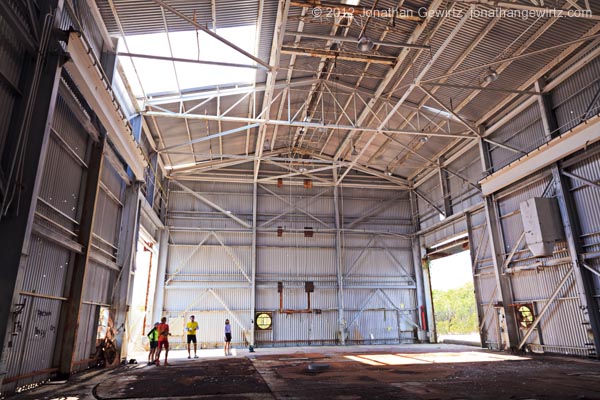I initially posted about the Aerojet ruins after my first visit more than five years ago. I’ve been back a few times since, most recently in July. The site is mostly the same but continues to deteriorate due to neglect, vandalism, a harsh environment, and in some cases removal of equipment as salable scrap by some state agency or other. For example, the machinery visible along the inside wall of the rocket test shed in this 2008 panoramic photo had been pretty well stripped by this July:

Here’s how the inside of the shed looks now, facing away from the wall with the machinery:

Note the circular steel cover on the floor, that almost fills the width of the shed. This cover prevents people from falling into the rocket test pit which is quite deep. Several test firings were conducted here in the late 1960s. The shell of the rocket motor was mounted vertically in the pit and propellant was poured in around a cylindrical core and allowed to harden. After the propellant hardened the core was removed and the rocket nozzle was installed, facing up. The corrugated metal shed was mounted on rollers and was moved out of the way before each test. There is much more information, including a photo of a test firing, at this page at astronautix.com. Note the size of the shed relative to the rocket exhaust plume.
This is the inside of the test pit as photographed through a rust hole in the steel cover:

It is a big hole. (The comments on my 2007 post include reports from people who climbed down into it. I suspect that many other people have done so as well.) The white cylinder in the middle is the shell of one of the Aerojet 260-inch diameter motors, probably the SL-2 SL-3 mentioned in the Astronautix article linked above. It might be nice to see it, and perhaps the surrounding infrastructure, preserved as a technology museum but it seems unlikely that this will ever happen.
Was this the facility in the Azusa/Irwindale area?
Mike
It’s in the Everglades, SW of Miami.
Jonathan – where I live Aerojet has had a main facility – I can remember in the latter 60s – being a good 30 miles away but on a still summer’s evening hearing them testing one of those Saturn rockets. 30-40 miles away.
And those weren’t even the “big ” rockets of the 1st stage of the Saturn V – they were “little” rockets.
Here’s more info on this site –
http://someplacelse.net/Everglades_Moon_Rockets_XHC.html
That site has a lot of information. If he is correct I was wrong on the shape of the rocket motor core, but that’s a small point. The author alludes to danger and mystery, but it seems to me that this is a story of a mid-sized Great Society boondoggle that was pitched to nearby agricultural communities as a source of future jobs but that never panned out.
His reference list includes Doug LaRue’s informative documentary, which I have watched (courtesy of Mr. LaRue) but haven’t yet gotten around to blogging about. Maybe one day…
Cool stuff thanks for sharing.
BTW, you mention “the highest hill in South Florida” in the original article…
Not so sure of that.
https://maps.google.com/maps?q=3000+NW+48TH+ST+(HILTON+RD)+POMPANO+BEACH+fl&hl=en&ll=26.282591,-80.168931&spn=0.007003,0.01929&sll=26.144324,-80.189917&sspn=0.015468,0.01929&t=h&hq=3000+NW+48TH+ST+(HILTON+RD)&hnear=Pompano+Beach,+Broward,+Florida&z=16&layer=c&cbll=26.282591,-80.168931&panoid=U1OFVhDqqTeH-bwnz0ciZw&cbp=11,90,,0,0
That may not be the highest point in Florida, but it’s probably pretty close, since Florida’s official highest point is only 345 ft, at Britton Hill waaay up in the panhandle.
;-)
Still, an interesting bit of Florida space coast history of which I was unaware.
Google Earth tells me the highest point in that area is 4 meters. Rolling the angle (shift up arrow or down arrow) way down shows me that is one amazingly flat part of the world.
Bupkis, that’s a landfill.